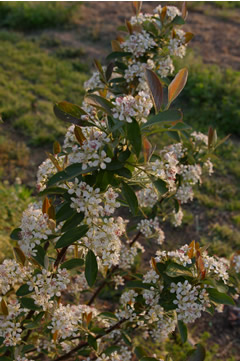Aronia Arbutifolia ‘Brilliant’
go.ncsu.edu/readext?222833
en Español / em Português
El inglés es el idioma de control de esta página. En la medida en que haya algún conflicto entre la traducción al inglés y la traducción, el inglés prevalece.
Al hacer clic en el enlace de traducción se activa un servicio de traducción gratuito para convertir la página al español. Al igual que con cualquier traducción por Internet, la conversión no es sensible al contexto y puede que no traduzca el texto en su significado original. NC State Extension no garantiza la exactitud del texto traducido. Por favor, tenga en cuenta que algunas aplicaciones y/o servicios pueden no funcionar como se espera cuando se traducen.
Português
Inglês é o idioma de controle desta página. Na medida que haja algum conflito entre o texto original em Inglês e a tradução, o Inglês prevalece.
Ao clicar no link de tradução, um serviço gratuito de tradução será ativado para converter a página para o Português. Como em qualquer tradução pela internet, a conversão não é sensivel ao contexto e pode não ocorrer a tradução para o significado orginal. O serviço de Extensão da Carolina do Norte (NC State Extension) não garante a exatidão do texto traduzido. Por favor, observe que algumas funções ou serviços podem não funcionar como esperado após a tradução.
English
English is the controlling language of this page. To the extent there is any conflict between the English text and the translation, English controls.
Clicking on the translation link activates a free translation service to convert the page to Spanish. As with any Internet translation, the conversion is not context-sensitive and may not translate the text to its original meaning. NC State Extension does not guarantee the accuracy of the translated text. Please note that some applications and/or services may not function as expected when translated.
Collapse ▲Year 1
Can be sold as green berries or as red; Very attractive berries; Transplanted easily, our cool wet summer (Zone 5) helped it establish, no disease problems.
Year 2
Easy to grow; pretty good fruit set.
Problems
Year 1
Japanese beetles were heavy for us this year; No problems so far, small problem with Pear Slugs (Caliroa cerasi) at the end of the summer.
Year 2
None
Postharvest
Year 1
Our testing was with plain water. One trialer also noted a vase life of 14 days.
Year 2
None
Trial Data
Year 1
| Plants Flowering (%) | Plants Dead at End of summer (%) | Yield (stems/plant)¹ | Stem Length (inches)¹ | Market Appreciation Rating² | Repeat Again Rating² | Ease of Cultivation Rating² | |
|---|---|---|---|---|---|---|---|
| Average | 67 | – | – | 5.5 | – | 3.7 | 4.5 |
| Range of Responses | 0-100 | – | – | 3-8 | – | 2-5 | 4-5 |
Year 2
| Plants Flowering (%) | Plants Dead at End of summer (%) | Yield (stems/plant)¹ | Stem Length (inches)¹ | Market Appreciation Rating² | Repeat Again Rating² | Ease of Cultivation Rating² | |
|---|---|---|---|---|---|---|---|
| Average | 100.0 | 0 | 3.0 | 36.0 | 4.0 | – | 5.0 |
| Range of Responses | 100 | 0 | 3 | 36 | 4 | 5 |
¹Data shown are from those respondents who harvested stems. Some respondents may not have harvested stems because they were too short. Flowering stems may be longer next year after plants are established. See comments section for more details.
²1 to 5 scale, with 5 being the best. Market ratings are based on sales to wholesalers, retailers, or final consumers direct.
Supplier
Bailey Nurseries (BA)
1325 Bailey Rd.
St. Paul, MN 55119
651-459-9744
800-829-8898
FAX 651-459-5100




Comments
Year 1
Similar to Aronia melanocappa elata; Nothing harvestable this year, will wait for next, we have grow this variety, good seller for us; Fruit quality appears better on these plants than it does on plants I received from another source.
Year 2
Plants are still too small to harvest from; It is still a “new” planting to me, but I would like to see more vigorous growth from this plant.